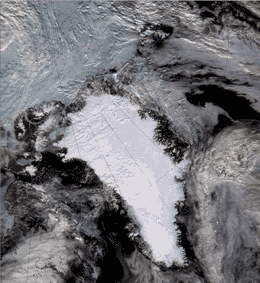
The spectral reflectivity of snow depends on snow
parameters such as the grain size and shape,
impurities, liquid content near the surface and
surface roughness. Newly fallen snow has a very
high reflectance in visible wavelengths. This
decreases as the snow ages, largely due to
melting and refreezing and to the natural addition
of impurities: As the snow melts, the snow's
grain size increases, and the melting of smaller
particles increases the density.
The ice reflectivity in the visible and near-infrared
wavelengths as observed from aircraft and satellites,
varies greatly. This depends on the overlying
material, impurities within the ice, and the presence
of surface melt water. A wide range of reflectivities
are known to characterise ice features as seen from
remote sensors. For instance, a glacier's reflectivity
is relatively low, but the ice may be covered by snow
and firn, in particular in the accumulation area, which increases the reflectivity.
Melt water and moraine material in the lower areas tend to reduce reflectivity.
The best remotely sensed images of ice are taken in clear
weather and daylight. However, in the Arctic, the weather is often cloudy,
and half the year the region lies in darkness. In addition, satellite images
from visible wave lengths are often of little use when mapping a large ice
sheet such as the one on Greenland. In the inland area it becomes all white,
with no contours.
To get around the problem of measuring inland ice, radar and microwave images
are often used. Since the radar carries its own source of “light”,
it also works at night, and it can “see” through cloud cover.
